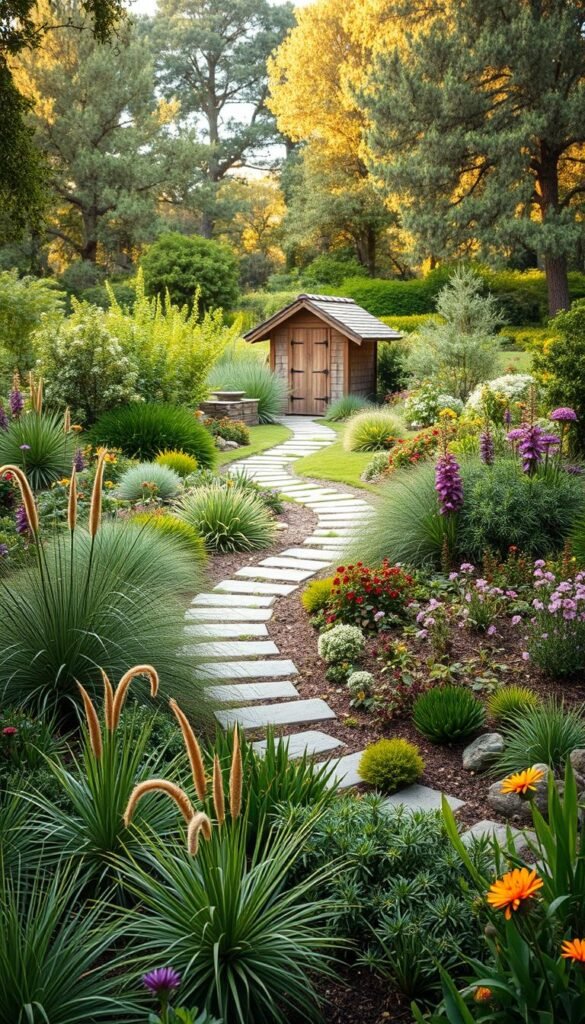Ever wish you could grow fresh herbs or veggies without endless hours in the garden? You’re not alone. Many struggle to balance their love for plants with packed workweeks and family duties.
Take Linda, a mom who grows 50+ plant varieties while juggling parenting and a career. Her secret? Working smarter, not harder. By embracing no-dig beds and automated watering, she cut her garden chores by half.
This guide shares proven ways to reduce effort without sacrificing harvests. Discover how perennial crops and strategic planting near your kitchen door can save time. Say goodbye to backbreaking weeding—hello to fresh flavors with minimal work.
Ready to transform your outdoor space? Let’s dive into the set-it-and-forget-it approach that keeps Linda’s Lazy Gardening Academy students thriving.
1. Embrace No-Dig Gardening for Effortless Soil Health
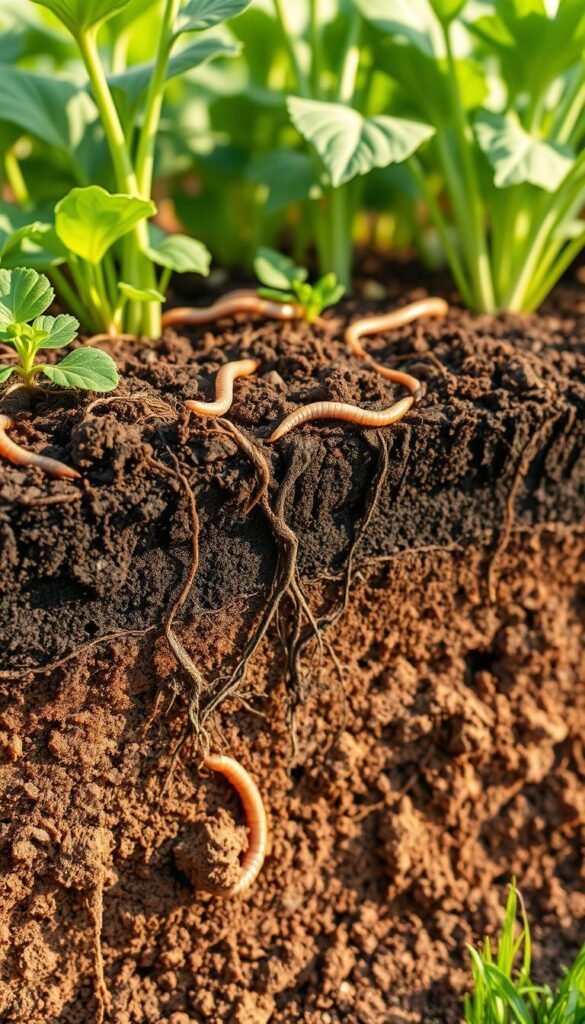
Healthy soil doesn’t require backbreaking work—just smart layering. No-dig methods build fertile ground by mimicking nature’s way of recycling organic matter. Instead of tilling, you’ll use cardboard and compost to create instant beds that suppress weeds and feed plants.
Layer Mulch and Compost for Instant Beds
Start with a base of cardboard to smother grass. Add a layer of compost (3–4 inches) topped with mulch like straw or wood chips. This “lasagna” approach saves hours—Linda’s students spend just 2 hours prepping beds versus 8 hours tilling. Plus, it’s cheaper than buying bagged soil.
For best results, mix mulch types:
- Straw (lightweight, breaks down fast)
- Leaf mold (retains moisture)
- Mushroom compost (rich in nutrients)
Why Traditional Tilling Wastes Time
Tilling disrupts the soil’s hidden helpers—mycorrhizal fungi and bacteria that plants rely on for nutrients. A UK school replaced 13 raised beds with no-dig plots and grew 15kg watermelons in compacted ground. Their secret? Cardboard sheets topped with compost, just like Charles Dowding’s method.
Skip plastic weed barriers—they harm earthworms. Instead, try “chop and drop”: leave plant trimmings as free mulch. Within a season, your garden will reward you with deeper roots and fewer chores.
2. Grow High-Use Herbs and Greens Close to Home
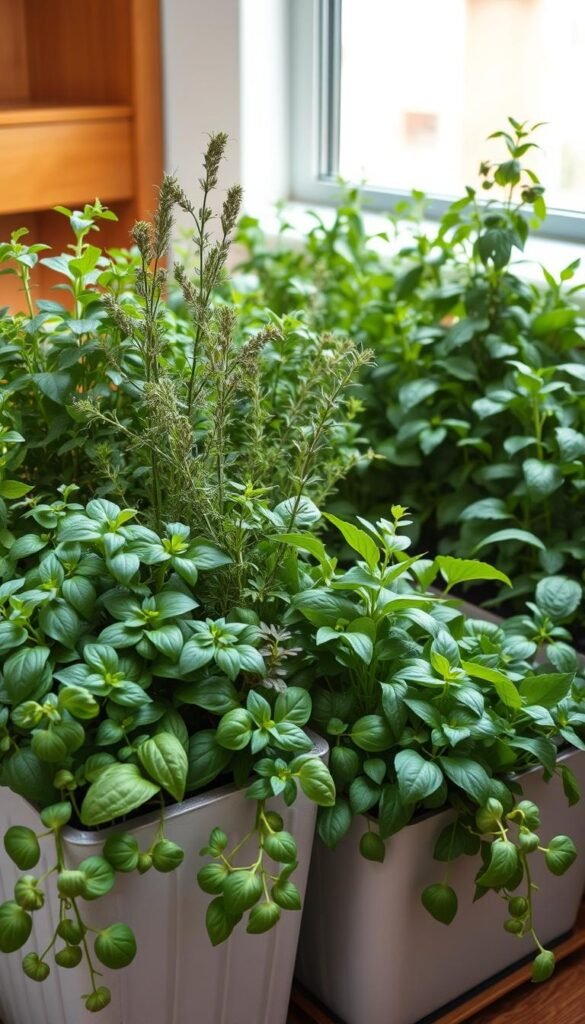
Want fresh flavors at your fingertips without constant upkeep? Planting herbs and greens near your kitchen cuts harvest time to seconds. Linda’s 5-gallon bucket salad table yields weekly greens—just steps from her back door.
Container Gardening for Kitchen-Door Convenience
Fabric containers boost root health and dry faster than ceramic. For patios, the Vegepod system combines self-watering and pest protection. Try tiered stands to maximize space:
- Windowsills: Basil, thyme, and parsley
- Under eaves: Cold-hardy vegetables like kalettes
- Vertical planters: Strawberries or minutina
Overwinter Herbs Indoors for Year-Round Harvests
African Blue basil and rosemary thrive indoors with 6+ hours of sunlight. Use self-watering pots for vacation periods. Pro tip: Group humidity-loving herbs like mint on trays with pebbles.
Prevent pests with neem oil sprays and weekly leaf inspections. Linda’s quick-pick salad mix—mâche, spinach, and edible flowers—takes 5 minutes to harvest. For more ideas, explore Tower Garden’s container guide.
3. Opt for Tall Raised Beds to Save Your Back
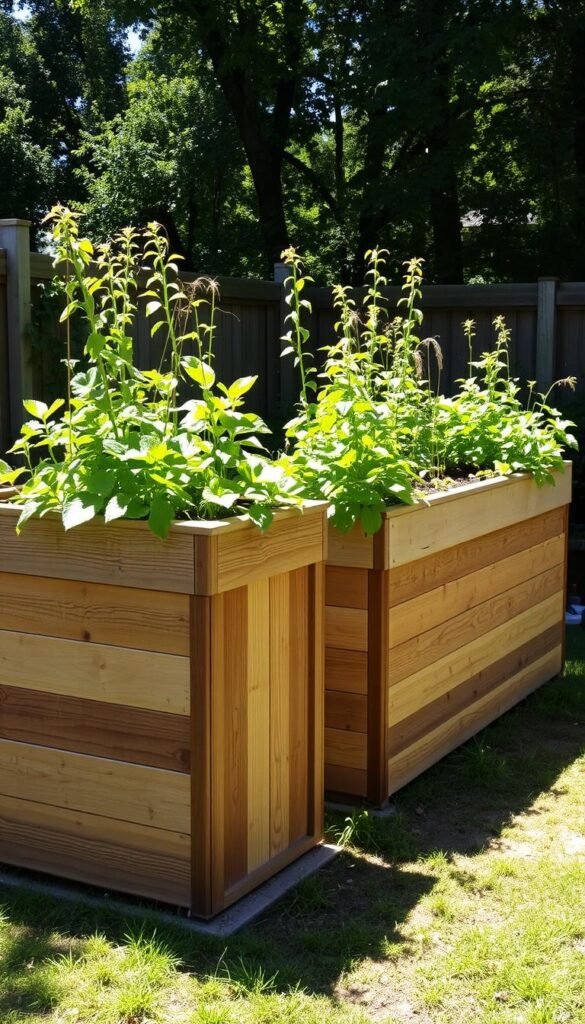
Bending over for hours can turn planting into a pain. Raised beds at the right height let you work comfortably while standing. Linda’s 22-inch cedar beds prove you don’t need to sacrifice comfort for a thriving garden.
Ideal Height (15-24 Inches) for Easy Access
The sweet spot for ergonomic beds falls between 15–24 inches. This range:
- Reduces strain on your back and knees
- Works for most adults, including wheelchair users
- Keeps soil warm for early planting
Untreated cedar lasts 7–10 years and resists rot naturally. At $3.15 per fence post, it’s budget-friendly too. For windy spots, anchor corners with rebar driven 12 inches deep.
Building Raised Beds Over Poor Native Soil
Transform problem soil by layering materials directly in your frame. The perfect mix:
- 30% compost for nutrients
- 50% topsoil for structure
- 20% perlite or vermiculite for aeration
Skip digging—just stack layers like a lasagna. Add trellises to vertical frames for climbing plants. Round sharp edges with sandpaper for child safety.
For clay areas, drill drainage holes along the sides. Winterize beds by topping with straw mulch. Discover more budget-friendly raised bed designs that save time and money.
4. Plant Perennials for Set-and-Forget Harvests
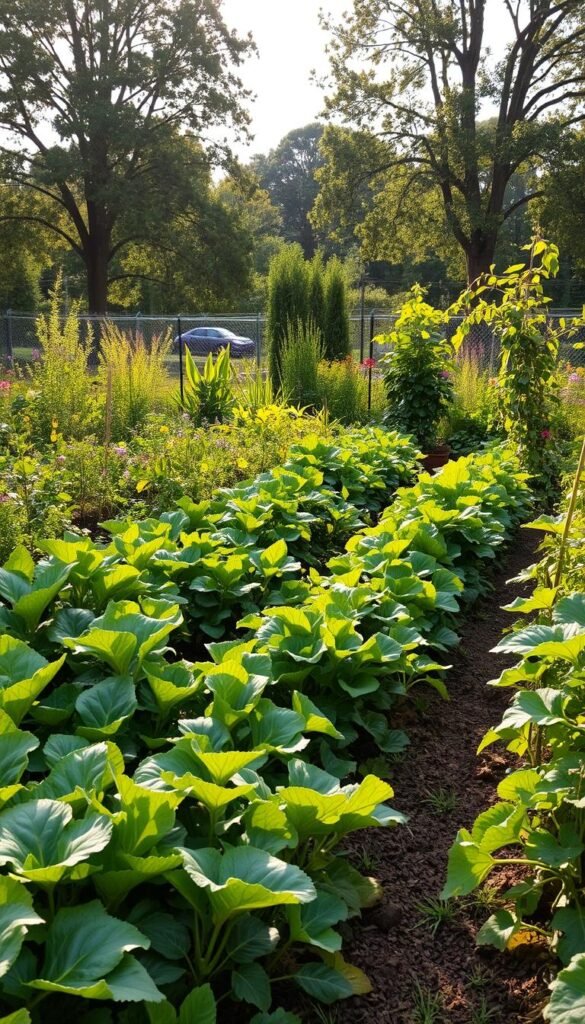
Imagine harvesting fresh produce year after year with just one planting. Perennial plants like asparagus and tree collards require minimal care once established, freeing up your time while providing steady food.
Top Perennial Vegetables: Asparagus to Tree Collards
Nine Star broccoli thrives for 5+ years, while Egyptian onions multiply annually. For warm climates, Malabar spinach climbs trellises with zero replanting. Here’s how to start:
- Zones 3–5: Plant asparagus crowns in spring; harvest lightly in year 3.
- Zones 6–9: Tree collards yield leafy greens year-round with winter protection.
- Guild planting: Pair sea berries (nitrogen fixers) with fruit trees for mutual benefits.
Berry Bushes and Herbs That Come Back Annually
Raspberry ‘Polka’ resists pests and fruits for a decade. Divide roots of mint and oregano every 3 years to prevent overcrowding. Pro tips:
- Build berry cages from PVC and bird netting to protect yields.
- Prune tree collards in late winter to encourage tender new growth.
- Horseradish planted near apple trees deters borers naturally.
5. Choose Heat-Tolerant Varieties to Extend Seasons
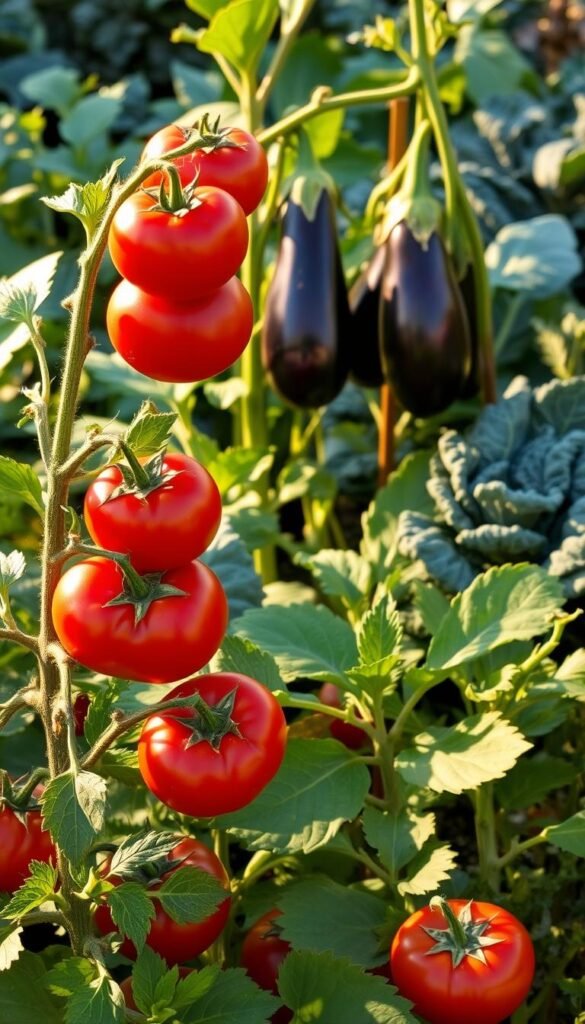
Scorching temperatures can wilt even the hardiest plants—unless you plan ahead. Selecting drought-resistant varieties lets your garden thrive when others fade. Pro tip: Look for “arid climate adapted” labels in seed catalogs.
Seed Catalog Tips for Drought-Resistant Picks
Reputable suppliers like Adaptive Seeds and Baker Creek highlight heat ratings. Eggplant ‘Florida High Bush’ handles 100°F soils, while tepary beans need just 12″ of water annually. Consider these winners:
- Tomatoes: ‘Heatmaster’ (sets fruit at 92°F)
- Greens: Malabar spinach (climbs trellises in full sun)
- Root crops: ‘Navajo’ watermelon (thrives in clay soils)
Space drip lines 12″ apart for xeric plants like okra. Bury unglazed ollas (clay pots) between plants—they release water slowly as soil dries. For coastal areas, consult salt tolerance charts before planting.
Install 30% shade cloth in early summer. It lowers leaf temps by 10°F without blocking light. Mulch 3″ deep around heat-loving vegetables to cool root zones. This prevents blossom drop in peppers and beans.
Map microclimates—south-facing walls radiate heat at night. There, plant ‘Sun Gold’ cherry tomatoes that ripen 2 weeks earlier. Succession plant every 3 weeks with quick-maturing seeds like ‘Space’ spinach for nonstop harvests.
6. Harvest Early and Often—Even the Leaves!
Unlock hidden yields by picking leaves and buds most gardeners overlook. Your plants offer more than the obvious fruits—think squash leaves, pepper greens, and kale stems. These extras pack flavor and nutrients while reducing work.
Edible Leaves of Squash, Peppers, and More
Young squash leaves are tender when sautéed with garlic. Pepper greens add a mild spice to stir-fries. *Pro tip*: Avoid nightshade leaves (tomato, eggplant) unless cooked—they contain solanine.
Compare nutrient density in common greens vs. fruits:
| Plant Part | Vitamin A (IU) | Vitamin C (mg) | Iron (mg) |
|---|---|---|---|
| Squash leaves | 2,400 | 28 | 2.7 |
| Pepper greens | 1,100 | 45 | 1.2 |
| Kale buds | 3,200 | 60 | 1.5 |
Bonus Crops from “Spent” Plants Like Kale Buds
After kale bolts, its flower buds taste like broccoli. Blanch and freeze them for soups. Radish seed pods add crunch to salads—harvest when tender.
- Regrow: Cut greens 2″ above the soil to spur new leaves.
- Inspect: Check for pests during harvest; sterilize shears after.
- Preserve: Dry herb leaves or freeze in olive oil cubes.
Linda’s students use these tricks to stretch their vegetables’ lifespan. Try broccoli raab flowers in pasta—they’re a gourmet freebie!
7. Use Living Mulch to Weed and Feed Simultaneously
Turn weeding into harvesting with smart plant partnerships. Living mulch suppresses weeds, enriches soil, and even provides edible yields—all with zero extra work. Linda’s students replaced 80% of their weeding time by planting radishes and nasturtiums between crops.
Radishes and Lettuce as Ground Cover
Fast-growing radishes (like ‘Daikon’) break up compacted ground while shading soil. Interplant them with lettuce to create a leafy canopy. Here’s why this duo wins:
- Space efficiency: Seed 6 radishes per square foot; harvest greens at 3 weeks.
- Weed suppression: Lettuce’s broad leaves block sunlight from invaders.
- Chop-and-drop fertilizer: Radish tops add nitrogen when trimmed.
Nasturtiums for Pollinators and Pest Control
These vibrant flowers lure aphids away from tomatoes while attracting bees. Plant ‘Alaska Mix’ nasturtiums as a trap crop—their peppery leaves are edible too. Pro tips:
| Plant | Benefit | Best Paired With |
|---|---|---|
| Radish | Breaks soil compaction | Lettuce, carrots |
| Nasturtium | Deters squash bugs | Cucumbers, zucchini |
| Crimson clover | Fixes nitrogen | Corn, brassicas |
Avoid allelopathic pairs like sunflowers with potatoes—they stunt growth. Instead, try underplanting tomatoes with basil. Both thrive in warm soil and repel pests naturally.
8. Automate Watering with Drip Irrigation
Say goodbye to dragging hoses or forgetting to water. A well-designed drip irrigation system delivers precise moisture to plant roots while saving you time. Linda’s setup—paired with a rain sensor—cuts her watering chores to just 10 minutes weekly.
How to Install a Timer-Based System
Start with a basic kit from your local garden center. Most include:
- Pressure regulators (15–30 PSI for standard systems)
- 1/2-inch mainline tubing and micro-tubing
- Adjustable emitters (0.5–2 gallons per hour)
Connect to a spigot using a water timer. Pro tip: Morning cycles reduce evaporation. For sloped yards, place emitters uphill—gravity helps distribute moisture evenly.
Zone your garden by water needs. Group thirsty plants like tomatoes together. Drought-tolerant herbs can share a line with lower flow rates. Learn more about balcony-friendly drip setups for small spaces.
Why Drip Lines Reduce Disease and Pests
Targeted watering keeps leaves dry, preventing fungal issues. Studies show basil grown with drip has 60% fewer leaf spots. The system also deters pests:
| Problem | Drip Solution |
|---|---|
| Slugs | Dry soil surface creates barriers |
| Aphids | No excess moisture to attract them |
| Root rot | Prevents soil saturation |
Winterize your irrigation by blowing out lines with compressed air. Store removable parts indoors. Come spring, flush filters and check for leaks at connectors. With minimal care, your drip irrigation will last 5–7 seasons.
9. Compost in Place to Skip the Bin
Skip the compost pile and feed your garden directly where it grows. Linda’s trench method saves 3 hours monthly by eliminating bin turning and hauling. Just bury scraps where plants need nutrients most.
Trench Composting Kitchen Scraps Directly
Dig a 12-inch trench between crop rows for rodent-resistant compost. Layer scraps with browns like shredded paper to balance carbon. Key advantages over bins:
- Vermicomposting trenches: Add red wigglers under 6″ of soil for faster breakdown
- Bokashi boost: Ferment scraps first to speed decomposition by 2x
- pH control: Bury citrus near blueberries, eggshells near tomatoes
Sheet composting works for large areas. Alternate 2-inch layers of greens (grass clippings) and browns (cardboard). Ready in 4-6 months—no digging required.
| Method | Time to Ready | Best For |
|---|---|---|
| Trench | 2-3 months | Row crops |
| Sheet | 4-6 months | New beds |
| Bokashi + Trench | 1 month | Heavy feeders |
Prevent nitrogen loss by covering trenches with straw. For odor-free compost, add microbial inoculants like compost tea. Thermophilic methods (hot piles) kill weeds but require more work than cold trenching.
10. Leave Plants Standing for Winter Soil Boost
Winter doesn’t mean your garden stops working for you—smart plant placement now pays off later. Standing stems and roots feed microbes, trap snow moisture, and shelter pollinators. This lazy strategy builds healthier soil while you sip cocoa indoors.
“Chop and Drop” for Free Mulch and Nitrogen
Come spring, cut stalks at the base and let them decompose naturally. Sunflower stems and corn stalks release nitrogen as they break down—like slow-release fertilizer. Pro tip: Use pruners to speed up the process for woody plants.
- Legumes: Pea vines fix nitrogen in root nodules
- Grasses: Rye forms dense mats that suppress weeds
- Comfrey: Deep roots mine potassium from subsoil
How Dead Foliage Shelters Beneficial Wildlife
Hollow stems become insect hotels for ladybugs and lacewings. Seed heads feed finches—leave these standing:
| Plant | Wildlife Supported |
|---|---|
| Echinacea | Goldfinches (seeds), leafcutter bees (stems) |
| Milkweed | Monarch chrysalises, tussock moth larvae |
| Brassicas | Overwintering aphid predators |
Delay cleanup until soil reaches 50°F to protect mycelium networks. Your plants’ “mess” is next season’s success!
11. Enjoy Your Lush Garden—With Time to Spare
Your garden should give you joy, not stress. With these smart strategies, you’ll spend less time on chores and more on relaxation. Track progress with simple tools like maintenance calendars or yield trackers.
Share the harvest—and the work—with neighbors through skill swaps. Preserve extra vegetables by freezing or drying. Involve kids with fun projects like sunflower forts or herb sensory bins.
Remember, a thriving space needs gentle care, not perfection. Try mindful moments while watering or pruning. These small steps create big rewards with minimal effort.
Ready to dive deeper? Explore the Lazy Gardening Academy for advanced set-it-and-forget-it techniques. Your future self will thank you!

